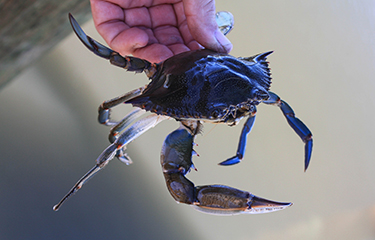US state of Virginia could reopen its winter blue crab harvest

The U.S. state of Virginia is reportedly considering whether to reopen its winter blue crab harvest – fifteen years after the fishery was closed.
In 2007, Virginia closed its winter blue crab dredge fishery season for the first time to rebuild the Chesapeake Bay’s crab population. The drop in population was enough that in 2008 the U.S. Department of Commerce declared a commercial fishery disaster for the Chesapeake Bay blue crab fishery – the first time the crab fishery had received such a designation.
In 2009, the Virginia Institute of Marine Science determined that the closures were justified after dredge surveys found that while the population had increased, it was still undergoing poor recruitment and the population of young crabs was still at an 18-year low. Scientific data in 2008 also indicated the bay-wide population of blue crabs had dropped 70 percent since 1993.
That population still hasn’t fully recovered to 1993 levels. Surveys over the last four years found that the population has continued to decline, with the adult female population sitting at 150 million, according to the Chesapeake Bay Foundation. However, the adult blue crab female population increased in 2023 compared to 2022.
Now, the Bay Journal reports that the Virginia Marine Resources Commission is considering a regulatory framework to reopen the long-closed winter harvest. The blue crab fishery is one of Virginia’s most lucrative, and in 2021 high prices resulted in the fishery pulling in USD 35 million (EUR 33 million).
“Watermen need something like this to lean on,” Virginia Watermen’s Association President James “J. C,” Hudgins told the Bay Journal. “I think it’s something we could look at on a minimal basis, a managed basis.”
The commission’s Crab Management Advisory Committee, the paper reported, is proposing the fishery only reopen with heavy concessions – such as a reduction in permits from the 58 handed out in 2008 to just six.
The original reasoning behind closing for the winter was to protect female crabs, which tend to account for 90 percent of the winter harvest as females migrate to the southern edge of the Chesapeake Bay to release eggs. Now, crabbers are saying that due to climate change waters are warming earlier in the year and staying warm later in the fall – resulting in crabs spending less time hibernating in the mud.
The commission ultimately voted 6 – 3 to review the proposal.
Virginia’s blue crab harvest period has already been extended by the commission, with the crab pot closure date pushed back to 16 December, rather than 30 November. Lower bushel limits are also beginning later on 1 November instead of 1 October.
The reason for the later season was to give watermen a chance to harvest crab under more favorable pricing, the Bay Journal reported.
Photo courtesy of Vikie Butner/Shutterstock






Share